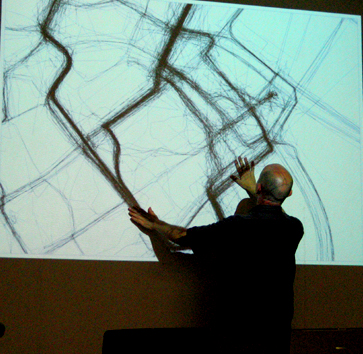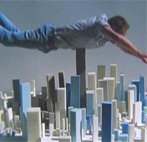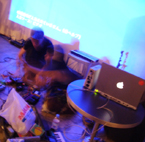trampoline
Trampoline is a platform for new media arts based in Nottingham and Berlin. Its purpose is to promote the innovations of emerging artists on both a local and international level, providing a platform for experimentation and new exposures while also encouraging new networks and discussions which contribute to education, research and development.
I contributed to Trampoline from July 2005-December 2006 as event curator. Below you can find details of three events which I coordinated in 2006.

In 2006 I realized 3 projects as curator for Trampoline.
l Challenging Geographic borders and communication barriers
l Mobile Media Bus
l Urban Play
These events pursued an investigation into alternative geography, new forms of mobility and the transformation of our daily spaces through new media technology.
challenging geographic borders and communication barriers

Nottingham’s platform for new media art begins its Spring 2006 Programme this March - we are sending out our radar across the globe in the search for challenging new work. This is an opportunity to plug into the innovations of Nottingham/regional based artists and at the same time connect with international media art developments. Trampoline is always looking to expand and find innovative ways of connecting spaces in the global age, overcoming geographical distances via digital technologies. Trampoline is extending its antennae to both transmit and receive in its event of regional and international creative exchange. Questioning geographic borders and communication barriers in the age of global connectivity, we will be asking, what is their state of existence and what is their relevance today? New barriers are continuously broken yet new divisions are formed. In today’s global network, all the world is invited, but some are still excluded. Trampoline will present work which contributes to these debates, challenges our notions of these boundaries and creatively comments on our entangled yet fragmentary network. From video, animation, installation, sculpture, performance, live music and web streaming Trampoline encourages all forms of new media expressions.
active ingredient

This program included a presentation by Active Ingredient on their new project Love City which merges three cities together in a virtual space created by the interactions between residents of each urban space. Derby, Nottingham and Leicester were brought together in a ménage a trois through the mobile phone communications of its inhabitants. The three cities being overlayed to create correspondence between particular physical locations and the people in these locations could have the opportunity to communicate to each other by text, even though they did not know each other. The project took the form of a game of love in which you had to send heartfelt messages to complete strangers to convince them to be your partner in the game, once you had been accepted by a person in each other city you would begin to create off spring in the virtual world, which would act as your avatars and help you to make more connections with people, The aim being to populate the virtual city and contribute to its development. This project clearly demonstrates the crossing between the virtual and the physical world, but also the crossing between one city to the next in a transformation which brings them into one.
jean-gabriel periot

‘dies irae’ a poetic voyage through places throughout the world in one continuous path. The work questions how we differentiate one place from another, as spaces constantly flow from one to the next in a simultaneous merge which leaves our location unclear.
myriam thyes

Euro 2020 presents national flags (real and imaginary) from around the world gradually merging from one to the other. The work evokes questions of political alliances, globalization and citizenship
no big deal

Internet works – no-big-deal http://www.no-big-deal.net/
No Big Deal deals with the idea of a "global city". It is an attempt to translate the world that in economic sense is connected through the same brands into the internet. On the graphic surface the user has the possibility to explore different urban situations. Through clicking on different persons she/he can enter a dialog with some of the people living in this city. They refer to their different experiences in this apparently similar world.
analysis
New technology and in particular the internet are often promoted as steps towards a utopian ideal of global connectivity Microsoft’s ‘where do you want to go today?’ the end of the nation, McLuhan’s global village but there is still a very real digital divide in which this promise may ultimately be an exclusive myth. The event tried to examine both sides of this debate. New media is said to set us free from geography as theorist Stephan Bates outlines in ‘The end of geography’, the shift which has occurred in relevance and limitations of locality within our lives. His comments are worth quoting at length:
"Geography blended with time equals destiny," the poet Joseph Brodsky once wrote. Indisputably, geography has sculpted human destiny. Proximity once circumscribed awareness. People knew, and knew about, only what was close to them; a village fifty miles away might as well have been a continent away. Technology gradually stretched the fetters of geography, enabling people to cast themselves and their ideas over wider and wider areas. Knowledge and culture spread. People migrated. State authority expanded, from village to city-state to nation to empire. Even so, geography has continued to regulate people's lives. It has shaped options in employment, housing, education, and relationships. It has molded political institutions, national aspirations, culture, knowledge, and identity.
But for how much longer? New information technologies--today's Internet, tomorrow's Global Information Infrastructure--trivialize geography. The technologies let us learn, almost instantly, the thoughts of someone on the other side of the globe; his whereabouts becomes as immaterial as his shoe size. Just as important, the technologies let us talk back. Like broadcasting, the Internet delivers the world to us; unlike broadcasting, it also delivers us to the world.
Presented 1996 Symposium: Theories and Metaphors of Cyberspace University of Vienna
This presents us with technology as an untethering device, unleashing us from the bounds of place to become at once everywhere. Paul Virilio also comments upon the end of geography in The Information Bomb (2006:9) but marks this not as a liberating and connecting force but one of effective imprisonment, in which we become effectively even further immobilized in a fixed point as we encounter all destinations before even departing.
However as physical spaces are supposedly discarded there is a highly concentrated use of spatial terminology used in relation to communication technology. This dichotomy is well discussed by Stephan Graham in 'The end of geography or the explosion of place? Conceptualizing space, place and information technology' 1998. Here he investigates the transference of spatial language to the digital realms and the relationship between physical and virtual space in which they are both constructing each other. We must be wary of the claims of the death of distance made by those such as Frances Cairncross as Heidegger realizes 'despite all conquest of distances the nearness of things remains absent', we may have the illusion of being able to enter any place at any time but the reality of place remains distant and intangible for us.
Can we challenge communication barriers through technology? We may have online translators, electronic dictionaries and speech convertors, but haven’t overcome language difference which is of course intrinsic within any language itself too. We can be at great distance from each other and interact through phone, email, webcam etc. but new technology can also form new communication barriers as we must first become media literate and then realize that the contents of communication is always transformed through its medium. Furthermore the digital divide is not just about who is and who isn’t connected to the internet, it includes general access to information and communication technologies and also understanding of these technologies, being able to use them effectively.
mobile media bus

''Trampoline will be joining forces with Trigger at Q-Arts Derby this June, to bring you an evening of cross-disciplinary experimentation. Trigger is an event which brings artists together from diverse backgrounds and talents in explorative collaboration.
Trampoline will be making its contribution to the event with a bus full of Nottingham artists. Our platform for new media art will take the form of a coach, laden with electrical and digital goodies, we will be travelling from Nottingham to Derby, with live performances on the way and opening up as an exhibition and performance space as we arrive at Q-Arts.''
This project offered a new format for Trampoline events. Taking place on a bus the event aimed to transform the experience of the journey through film screenings, live performance, interactive installation, I-spy and journey songs. It has always been an objective of trampoline to explore alternative forms of presentation, which take art beyond gallery spaces to attract new audiences and offer new exposures. This was an exciting opportunity to create a new dynamic event with a very particular environment of inside the bus and an ever changing environment outside of the bus.
The approach taken was very playful and attempted to create some sort of party/holiday like atmosphere. During the ride, music performances took place in which passengers were given instruments and were able to join in, seats had also been modified to become instruments – depending if you were sitting or standing sound would be activated, and the group was encouraged to join in sing-along bus songs. Each passenger was given a disposable camera to record their journey as well as being given an ‘I-spy’ quiz to try and draw their attention to the places they were passing through. Another work by Lori Amor attempted to make connections between passengers sitting apart from each other, for example between the front and the back of the bus using mobile devices containing a web camera and a small screen in which you could see the other person. When the bus arrived at its destination it became an installation space including a camera obscura, interactive installation, performance and film screening.
However it was also quite challenging to find work suited for this particular context to fit a landscape which is constantly changing and to continuously engage an audience in close proximity. Mobile projects do not have just one context to consider, they have an ever changing sequence of contexts which they need to be able to react to and adapt to. Site-specifity is not merely achieved by moving through a site but by creating a meaningful relationship with the various points passed through, along with an understanding that place is not indexical, it does not consist of grids on a map – flow of experience.
The full potential of the project was perhaps not realized but it is hoped to develop this kind of project further. I would like to present three examples of mobile projects which I feel have achieved this balance well and which can be points of reference for future developments.
moblab
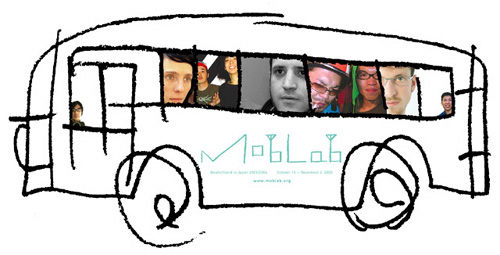 Moblab is a project initiated by curator Shikata Yukiko. The project
brought together German and Japanese artists
in a three week bus tour of Japan making stops in Ogaki, Sendai,
Matsumoto, Tokyo, Yokohama, Nagoya, Osaka, and Yamaguchi. At
each stop the participants would make a response to the local
context through exhibitions, workshops and live events. The bus
became a mobile gallery, studio and meeting place, constantly
changing its function and appearance and became even an art work in
itself as artists transformed it into a musical instrument, or a
mobile web camera, in the case of Exonemo who created the work Road
Movie on the bus.
http://www.exonemo.com/RM/indexJ.html
Moblab is a project initiated by curator Shikata Yukiko. The project
brought together German and Japanese artists
in a three week bus tour of Japan making stops in Ogaki, Sendai,
Matsumoto, Tokyo, Yokohama, Nagoya, Osaka, and Yamaguchi. At
each stop the participants would make a response to the local
context through exhibitions, workshops and live events. The bus
became a mobile gallery, studio and meeting place, constantly
changing its function and appearance and became even an art work in
itself as artists transformed it into a musical instrument, or a
mobile web camera, in the case of Exonemo who created the work Road
Movie on the bus.
http://www.exonemo.com/RM/indexJ.html
sightseeing bus camera
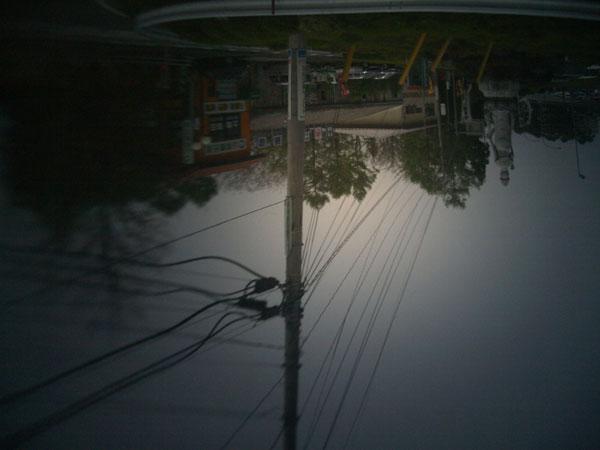 This is a highly successful, yet simple project
which captivates the viewer/passenger by changing one’s perspective
of the surrounding environment. It transforms the whole bus into a
camera obscura, with tracing paper –like material suspended along
the centre of the bus and seating arranged to face the gangway, the
windows were completely blacked out except 2-3 holes left in each
side, projecting an image of the (upside-down) outside world upon
the paper screen. As the paper is semi-transparant the image from
both sides of the bus can be seen together at once. To ride on the
bus camera is a very special experience
which although highly disorientating allows our image of the world
around us to be transformed.
This is a highly successful, yet simple project
which captivates the viewer/passenger by changing one’s perspective
of the surrounding environment. It transforms the whole bus into a
camera obscura, with tracing paper –like material suspended along
the centre of the bus and seating arranged to face the gangway, the
windows were completely blacked out except 2-3 holes left in each
side, projecting an image of the (upside-down) outside world upon
the paper screen. As the paper is semi-transparant the image from
both sides of the bus can be seen together at once. To ride on the
bus camera is a very special experience
which although highly disorientating allows our image of the world
around us to be transformed.
*
moving soundscape
As part of the Get It Louder festival in Shanghai, Ou Ning curated a project of sound installations for minicoopers. 20 artists had created sound works based on field recordings of the local area. During the festival audience members were able to board minicooper cars and be taken on a chauffer driven journey around the area, being able to select between the different routes of each artist. As they were driven on this route they were able to listen to the sound work on the car stereo system. These projects show a clear engagement with the environments through which they are traveling and allow a new relation to emerge between the audience and these spaces.
analysis
Mobility is strongly equated to freedom in today’s society. To be rooted to one place is to be burdened, to be imprisoned, the ability move from one place to another both physically and virtually is an indication of liberty. But as Doreen Massey has indicated one’s mobility is often based on another’s immobility or forced movement. As David Morley (2000), quoting Massey, observed, the mobility of affluent classes is “quite different from the mobility of the international refugee or the unemployed migrant as a social experience” (p. 200)—not to mention the immobility of groups of people unable to relocate from regions of poverty, famine, and warfare. To be mobile does not necessary mean to be untethered.
But mobility is greatly impacting upon our idea of place, as Miwon Kwon comments, site is no longer a spatiality but an itinerary 'a fragmentary sequence of events and actions through spaces, that is, a nomadic narrative whose path is articulated by the passage of the artist. Corresponding to the model of movement in electronic spaces of the Internet and cyberspace, which are likewise structured as transitive experiences, one thing after another, and not in synchronic simultaneity, this transformation of the site textualizes spaces and spatializes discourses.'
Movement is not necessarily from one point to another, as is expressed in the urban derive, whereupon the flaneur is not concerned with how to get from A to B but traverses the city in a new form of subconscious awareness, by which the environment can be newly encountered. Debord describes the derive as ‘A technique of transient passage through varied ambiences. The derive entails playful-constructive behaviour and awareness of psycho-geographical effects which completely distinguish it from the classical notions of the journey and the stroll. In the derive one or more persons during a certain period drop their usual motives for movement and action…and let themselves be drawn by the attractions of the terrain and the attractions they find there.’ (1981: 50) Mobility then can be a method of openness to the environment in which we can discover alternative narratives of place, through our movement through it. Certeau also alludes to this in the presentation of the walker as inscribing a poem upon the city (1984: 93). The derive allows for a political challenge to monopoly of urban space by the commercial, which attempts to govern movement in the city, directing it towards its own purpose, but the derive subverts the written rules of the city by writing its own text.
Positions of the Nomadic as described by Deleuze and Guattari are also highly relevant in this discussion in which the nomad traverses the land in a constant state of deterritorialization and reterritorialization, being at once detached but highly embedded in the components of place.
urban play

The city is paved with pixels, the flow of traffic becomes the flow of bits, the flow of people, the flow of electrons. Streets and circuit diagrams become meshed. The race has begun. Each one of us becomes a player in the game of the city, furiously manipulating the control pad, tapping buttons, flicking switches. Leaping from platforms, scaling the walls – the concrete/media playground is before us. Hurtling around corners, lunging up surfaces, shooting through the streets. Join the rush and surge of the city, find new ways to play the game.
Trampoline invites you to participate in this one day event to be held on 23rd November in Nottingham, UK. Its objective is to merge video gaming, art and design with the investigation of the city space. The structures of the city are increasingly pervaded by new media with screens, cctv, electronic networks, mobile devices, implements often designed to control our movement through urban space and even to remove us from our surroundings. We wish to investigate how new media can form an even tighter relationship with our immediate environment – challenge and subvert its conventional structures – hacking the city.

jkjkjk

blast theory
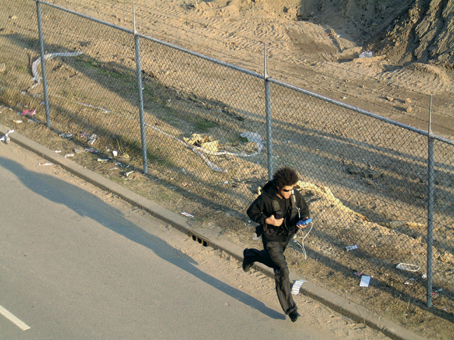
Renowned artist group Blast Theory are pioneering in their utlization of media technologies to play the urban environment. Blast Theory member, Matt Adams, gave a special presentation at this Trampoline event, introducing the recent work of 'Day of the Figurines' a virtual world which allows people to generate narrative through text messaging, and also providing an overview of past works, including 'Can You See Me Now?' a game played on the streets of a city using GPS and graphic interface to try and find a person you have not seen for a long time and wish to see again.
giles askham - aquaplayne

Giles Askham ‘Aquaplayne’
This work creates new surfaces for interaction in which the body’s motion through space creates ripples through that environment.
martin john callanan - sonification of you

Martin John Callanan ‘Sonification of You’
Makes tangible the invisible data flows around us by transforming the electromagnetic radiation of wireless networks, mobile phones, computers etc in a given space into audio signals.
carolina briones/ava fatah/chrion mottram - led carpet
 C
C
Carolina Briones, Ava Fatah, Chrion Mottram – LED Carpet
This collaborative group of researchers from University College London presented LED carpet devised for pavements and open spaces, creating a new layer to the urban fabric which reacts to passersby and encourages social interaction between strangers leading pedestrians to become participants.
jon aveyard - involution

Jon Aveyard ‘Involution’ This was an audio work which individual audience members could experience on headphones and portable device while walking though the city. The sounds were recorded with binaural microphones walking through areas of Birmingham. The audience in Nottingham experiences one city within another. The sounds within the ear and the sounds without become merged and the experience of the everyday city is transformed.
analysis
The event was able to attract a wide audience, especially due to its link with gaming, and the newly renovated spaces of Broadway Cinema lent themselves well to the presentation of the various works and performances.
However for an event so concerned with public urban spaces, it was unfortunate that not more works could have taken place outside on the streets. But investigating the possibility to present works in these spaces it became clear that a whole set of permissions and bureaucratic processes was required in order to use such spaces. The difficulty of gaining such permissions makes it often only possible to carry out interventions on a guerilla style basis, in the form of a temporary infiltration, like many of the projects mentioned above.
The work could have more impact with a presence in the open city space and encourage participation of other audiences, passersby, those unconnected with art. If the actual structures of the urban environment can be utilized in the presentation of the works then the creative potential of the city space is greater emphasized and would raise the conceptual and formal level. From this event I took the motivation to try and realize future projects in urban spaces.
urban vibe
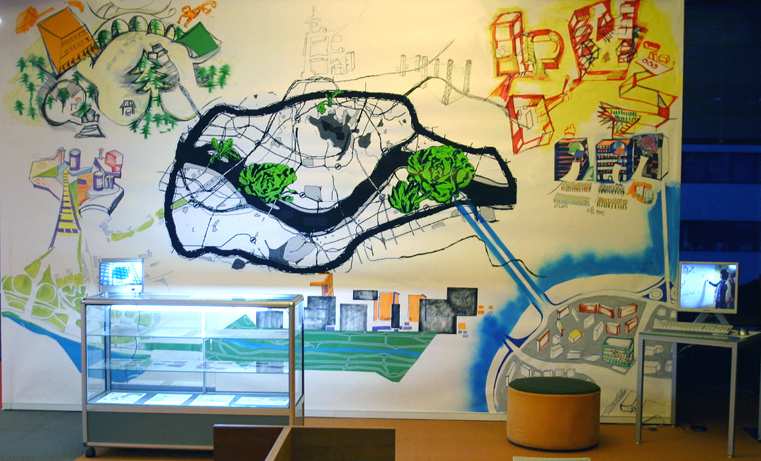
This was an innovative project curated by Park So-Hyeon at Nabi Art Center, Seoul. Working with a team of artists and engineers a number of collaborative and individual projects were realized which explored the use of media technology in the city and its creative potential.
INP (interactivity and practice) is the name for the collaborative group of artists, engineers and cultural theorists who are working together to develop their own individual and collective practice and formulate new dialogues and ways of working.
‘Urban Vibe’ very much emphasized play as a strategy for resistance to rigid systems formulated in urban space, proposing that a break in the everyday routine is necessary in order to be more aware of the spaces we inhabit.
This inspiring event presented 12 projects which were enacted upon the streets of Seoul. They included walking tours, multi-player games, interventions upon the public transport system and hacking of public and private communications technology to formulate new relationships between people and between the city.
graffitti research lab
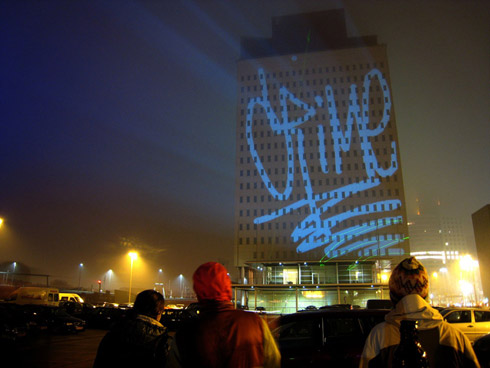
GRL is a group now famed for its guerilla style tactics to allow authorship in urban spaces. Using a simple technique of laser beam, connected to a computer, participants can draw upon buildings, leaving their temporary mark. Another project which has caught the imagination of many people is ‘LED Throwies’, easy to build devices which people can make themselves which light up in assorted colours and can stick to walls. The information on how to make them is open source so anyone can have a go. These were used in a form of demonstration in an event which encouraged people to throw these devices onto a structure in New York, covering vast surfaces with glowing lights. These devices have since been used for very political protests, including at the Beijing Olypic games forming ‘Free Tibet’ in glowing LEDS by the Olympic stadium.
urban games - pacmanhattan
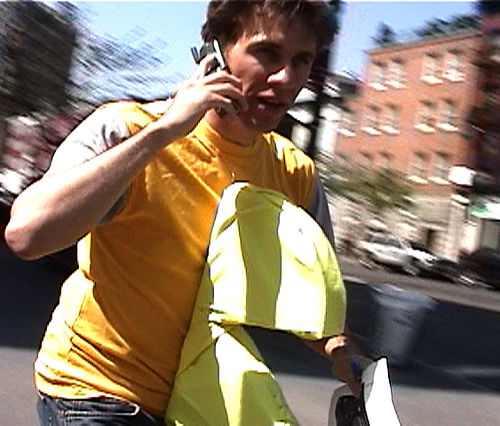
Urban games involving large groups of players using the city as a game board or a fighting ring have become very popular, evolving a strong sub-culture. Pac-Manhattan is an example of such a game. The grid of New York city is used to re-create a real-life version of Pac Man in which participants enact the roles of Ghosts and one player as Pac-man. Using mobile phones,wireless internet and custom made software the movements of the players are tracked and broadcast live over the internet.
cctv performance
l the surveillance camera players – Mediashed – Michelle Teran
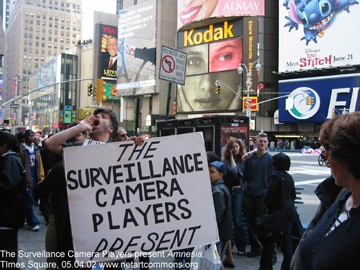
Another interesting phenomena is the use of CCTV for the creation of films and performances. Particular pioneers of this form of intervention have been ‘The Surveillance Camera Players’. In protest against the proliferation of CCTV in New York City, they began making performances to the cameras, initially for the security guards watching them and then for others passers by. Holding large signs and acting out in silence, various plays and protest performances. The city’s infrastructure of CCTV has become a popular medium for many artists. For example Mediashed initiated a project ‘Video Sniffin’ using a video receiver which can pickup the broadcasts of wireless CCTV, working with young people in London they created a film using the CCTV as their camera. They went on to utilize CCTV in one of Manchester’s major shopping centres to film ‘The Duellists’
Artist Michelle Teran also captures CCTV footage in her work ‘Life: A Users Manual’ in which she takes the audience on a performative voyeuristic tour of the city in which they watch the broadcasts of CCTV in shops, offices and homes.
control
The high penetration of technology into the fabric of the urban environment has often been presented with the promise of participation and immersion but this can in fact be interpreted as an entrapment, where we have no choice but to cooperate/be co-opted. To many technological society creates a relationship of dependency, the reliance upon technology for the running of our everyday lives, which therefore makes us deeply susceptible to technological ‘malfunction and misuse’ as Neil Postman observes.
Technology has a system, a way of functioning, which is different from other aspects of life’s rhythms, the argument is that we are increasingly forced to change our way of thinking to conform to that promoted by technological systems and as the Unabomber warns us this is not only a psychological change but will also lead to a biological change through developments in biotechnology. ‘Whereas formerly the limits of human endurance have imposed limits on the development of societies, industrial-technological society will be able to pass those limits by modifying human beings, whether by psychological methods or biological methods or both. In the future, social systems will not be adjusted to suit the needs of human beings. Instead, human beings will be adjusted to suit the needs of the system’ (Kaczynski 1995). Such notions of the human that must be molded to fit the machine are prevalent in the work of Ellul: "Modern technology has become a total phenomenon for civilization, the defining force of a new social order in which efficiency is no longer an option but a necessity imposed on all human activity" (1964: 17), Langdon Winner, who expresses in no uncertain terms ‘Technology is a source of domination that effectively rules all forms of modern thought and activity. Whether by an inherent property or by an incidental set of circumstances, technology looms as an oppressive force that poses a direct threat to human freedom’ (1977) and Neil Postman ‘Technopoly is a state of culture. It is also a state of mind. It consists in the deification of technology, finds its satisfactions in technology, and takes its orders from technology’ (1993: 71), to name but a few.
In our encounter of an embedded, mobilized technology we can be increasingly manipulated by other bodies of power, our movements tracked, our personal data collected, our habits of consumption, our medical history, our credit card rating, our choice of websites can all be monitored and can all be used in evidence against us. Deterritorialization and emeddedness can both be used as forms of control. As we have seen technology can uproot, lift people and objects from their context, from the relationships which give them identity and meaning, thus alienating them from themselves and others, alienated from their place of dwelling. This separation can weaken and isolate and place its object at risk. The individual is disempowered, no longer the individual, but a ‘dividual’, reduced to divisible units of ‘masses, samples, data, markets, or "banks."’ To Deleuze technological developments advance the grip of an exploitative, dehumanizing capitalism which forms the control society. And it is in this control society that technology may obtain such a level of emdeddness and lead us to such a point of immersion that the ‘play of power becomes invisible to us ‘propaganda [becomes] virtually unnoticed’ (1964: 22).
The promises of freedom therefore hide the actual processes of manipulation, liberty is a mirage which Virilio in particularly emphasises. ‘The suppression of national boundaries and the hyper-communicability of the world do not enlarge the space of freedom. They are rather the sign of its disappearance, its collapse, before the expansion of an all-too-tangible totalitarian power, a technological control over civilized societies that is growing ever more rapid and refined’ (1991: 11), noting that the very technologies which are used to guarantee freedom are also those used for incarceration. Foucault also describes the very structures and properties of power in terminology very familiar to that of media technology, as it ‘circulates’ ‘never localized’ ‘exercised through networks’ with multiple ‘relays’, in which individuals become conducting electrons ‘Power passes through individuals. It is not applied to them.’ Such a formulation provokes again the question if it is intrinsic within the nature of media technology to be a tool of power and control?

